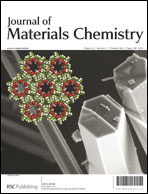A facile route to vertically aligned electrospun SnO2nanowires on a transparent conducting oxide substrate for dye-sensitized solar cells
Abstract
We demonstrate a large-scale production of aligned SnO2 nanofibers with a multi-nozzle electrospinning method combined with an air-shield enclosed rotating drum collector. The production rate by this multi-nozzle approach is several times higher than that of the single-nozzle electrospinning. The nanofibers produced were having a short range of diameters similar to the case of nanofibers produced by single nozzle


 Please wait while we load your content...
Please wait while we load your content...